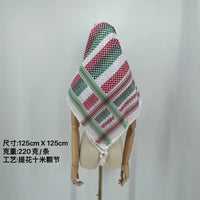Historical Significance of the Keffiyeh
The keffiyeh has a storied history dating back to ancient Mesopotamia, where it was worn by Babylonians and Sumerians. The term "keffiyeh" derives from the city of Kufa in Iraq. Traditionally, it was an essential item for Bedouins and farmers, offering protection from the harsh desert environment, including sandstorms and intense sun. Over time, the keffiyeh has also become a symbol of Palestinian nationalism and resistance, particularly during the Arab Revolt of the 1930s and the Palestinian struggle against Israeli occupation.

Practical Benefits of Wearing a Keffiyeh
1. Protection from Environmental Elements
2. Versatility in Everyday Use
- Head and Face Covering: Protects against sun, dust, and wind.
- Scarf: Provides warmth in cold weather.
- Towel: Lightweight and quick-drying, perfect for wiping sweat or drying off.
- Ground Cloth: Keeps you clean and dry when sitting on the ground.
- Bag: Can be tied to carry items.
- Emergency Bandage: Useful in first aid situations.

3. Fashion Statement
Conclusion:
The keffiyeh is much more than a simple piece of cloth; it is a symbol of cultural heritage, resilience, and practicality. From its historical roots in Mesopotamia to its modern-day applications, the keffiyeh offers a multitude of benefits, including protection from environmental elements, versatility in everyday use, and a unique fashion statement. Whether you are traveling through the desert, attending a political rally, or simply looking for a stylish accessory, the keffiyeh is a valuable addition to your wardrobe.
Explore the rich history and practical benefits of the keffiyeh by incorporating this timeless accessory into your daily life. Share this article with others to spread awareness of the keffiyeh's significance and versatility.






